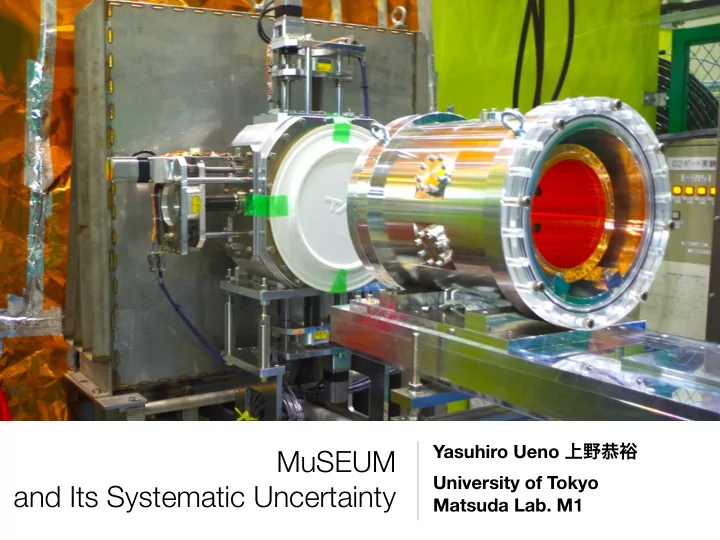

Yasuhiro Ueno 上野恭裕 MuSEUM University of Tokyo and Its Systematic Uncertainty Matsuda Lab. M1
Today’s Menu 1. MuSEUM (motivation, set up, uncertainties) 2. Muon beam profile monitor(BPM) and beam test
What Is MuSEUM Experiment? Mu onium S pectroscopy E xperiment U sing M icrowave • Precise measurement of muonium hyperfine structure (MuHFS) • @J-PARC Liu, et al. PRL82 771(1999) Muonium µ e 1S F=1 e - Δν µ + F=0 µ e
“There !is !a !reason ! physicists !are !so !successful ! with !what !they !do, !and !that ! is !they !study !the !hydrogen ! atom !and !the !helium !ion ! and !then !they !stop." – R. P . Feynman
Why Muonium Hyperfine Structure Indeed! Hydrogen(-like) atom spectroscopy played an essential • role in understanding physics (e.g.) Bohr Model, Lamb shift, bound QED… etc. The finite-size of proton, however, prevents physicists from testing • quantum electrodynamics (QED). Muonium = positive muon (µ + ) + electron (e - ) → purely leptonic • (two ‘point like’ particles) https://www.youtube.com/watch? v=rc9gwPB78lk
Why Muonium Hyperfine Structure Stringent Test of Bound-State QED Muonium → Two point-like particles no proton structure effect Determination of Muon Mass An external parameter for muon g-2 experiment @J-PARC(E34) or Fermilab Contribution to new physics search
Experimental Set Up
How To Measure? gas chamber positron detector magnet Gas Chamber µ + Kr gas muon beam 1.7T Magnet RF cavity
How To Measure? gas chamber magnet Gas Chamber e - µ + Kr
How To Measure? magnet Gas Chamber Muonium
How To Measure? magnet Gas Chamber Muonium positron detector e + NO spin flip!!
How To Measure? magnet Gas Chamber If we add HFS frequency… RF cavity
How To Measure? magnet Gas Chamber flip!! RF cavity
How To Measure? The spin did flip!! magnet Gas Chamber e + RF cavity positron detector
Uncertainties Previous experiment @Los Alamos Meson Physics Facility(LAMPF) magnetic field muon stopping distribution statistical to be suppressed Liu, et al . PRL82, 711(1999)
Muon Beam Profile Monitor (BPM) On-Line Beam Profile Monitor � O ff -Line Beam Profile Monitor (Main Topic of today)
On-line Beam Profile Monitor Designed and developed by S. Kanda (U. Tokyo) • Composite of very thin (~100µm) scintillation fibers • S. Kanda. J-PARC symp.
Off-line 3D Beam Profile Monitor design and development by T. U. Ito, JAEA • Composite of Scintillator , Gated Image Intensifier (IIF) and CCD camera • Determination of muon stopping distribution • S. Kanda. J-PARC symp.
Beam Test @J-PARC • Aim • Establish the operation of beam profile monitor • Evaluate the performance of the monitor Photo credit, H. A. Torii
Beam test RF cavity γ µ Scintillator CCD camera gas chamber
Reconstruction of 3D Distribution • Acquired image [mm] [mm] • Calibration for beam intensity is done
Future Prospects Reconstruct the muon distribution Operational test Improvement of under magnetic field scintillation sector
Summary Aim of MuSEUM: determination of the values of muonium HFS • Demonstration of beam profile monitor has been done • Data analysis is ongoing • Further study for muon stopping distribution and improvements • follows JPS @WASEDA, 21st MARCH, 2015 A.M.(DF room)
THANK YOU FOR YOUR ATTENTION!!
CPT and Lorentz invariance R. Bluhm. “Testing Lorentz and CPT Symmetry”, V. W. Hughes, et al . PRL87, 11(2001) http://users.ictp.it/~smr1951/Programme_files/08-Bluhm.pdf (2008), Jan 25, 2015. • Hyperfine transition frequency can exhibit sidereal time oscillation as the earth rotates • The bound of Lorentz violation parameter for muon sector (obtained from the previous Mu HFS)
Muon mass LAMPF experiment (last MuHFS experiment) decided m µ (120 ppb) • CODATA m µ → 30 ppb • CODATA = LAMPF+other theoretical calculations •
muonium HFS VS positronium HFS • µ µ /µ p → contribution to g-2 experiment on µ+ • positronium HFS → strong recoil effect, annihilation effect • positronium HFS uncertainty ~ppm A. Ishida, Ph.D. Thesis, (2014) while muonium HFS uncertainty ~10 ppb • positronium HFS ~200GHz muonium 4GHz
µ µ /µ p ratio • With these assumption, we can determine the muon- proton magnetic moment ratio • QED is correct • No SUSY • α and R ∞ is well determined (i.e. they are external parameters)
1s-2s VS HFS • The energy scale of hyperfine splitting is much smaller than that of 1s-2s transition • → better absolute energy resolution (i.e. better sensitivity to CPT and Lorentz violation)
Beam test - Validation-Gas Pressure 0.1 0.3 0.5 0.7 1.0 [atm]
Magnetic Field LAMPF experiment: the muon-stopping area excessed the area • where magnetic field was precisely measured → Large uncertainty related to magnetic field MuSUEM suppress these uncertainties from both sides - magnetic • field and muon stopping distribution Best effort has been (will be) done to reduce magnetic-field • uncertainty To suppress the uncertainty from muon stopping distribution, Muon • beam profile monitor is essential
Why Muonium Hyperfine Structure Muonium HFS is a good probe for bound QED theory • the experiment also • determines muon mass → better input parameter for new muon g-2 experiment at J-PARC and Fermilab � Test of CPT and Lorentz • invariance R. Bluhm, et al . PRL84, 1098(2000) P . Strasser, et al. Proceedings for NUFACT 2014, to be published in the Proceedings of Science.
Statistic Last muonium HFS measurement was at LAMPF (Los Alamos • Meson Physics Facility), USA The muonium HFS value by the LAMPF experiment is deteriorated • by insufficient statistic H-Line is a new high-intensity muon pulse beam facility@ J-PARC • The statistic acquired by H-line in four days is equal to the whole • statistic of LAMPF experiment Reduction of systematic uncertainty is important •
Recommend
More recommend